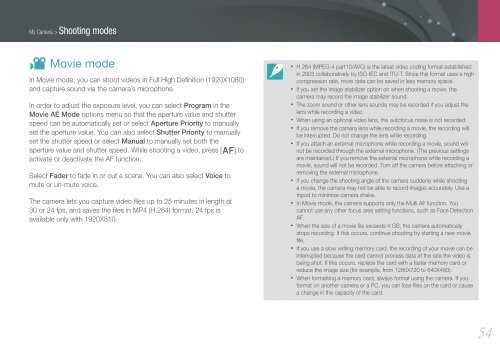Samsung SMART CAMERA NX1000 (EV-NX1000BABFR ) - Manuel de l'utilisateur 7.81 MB, pdf, Anglais
Samsung SMART CAMERA NX1000 (EV-NX1000BABFR ) - Manuel de l'utilisateur 7.81 MB, pdf, Anglais
Samsung SMART CAMERA NX1000 (EV-NX1000BABFR ) - Manuel de l'utilisateur 7.81 MB, pdf, Anglais
You also want an ePaper? Increase the reach of your titles
YUMPU automatically turns print PDFs into web optimized ePapers that Google loves.
My Camera > Shooting mo<strong>de</strong>s<br />
v Movie mo<strong>de</strong><br />
In Movie mo<strong>de</strong>, you can shoot vi<strong>de</strong>os in Full High Definition (1920X1080)<br />
and capture sound via the camera’s microphone.<br />
In or<strong>de</strong>r to adjust the exposure level, you can select Program in the<br />
Movie AE Mo<strong>de</strong> options menu so that the aperture value and shutter<br />
speed can be automatically set or select Aperture Priority to manually<br />
set the aperture value. You can also select Shutter Priority to manually<br />
set the shutter speed or select Manual to manually set both the<br />
aperture value and shutter speed. While shooting a vi<strong>de</strong>o, press [F] to<br />
activate or <strong>de</strong>activate the AF function.<br />
Select Fa<strong>de</strong>r to fa<strong>de</strong> in or out a scene. You can also select Voice to<br />
mute or un-mute voice.<br />
The camera lets you capture vi<strong>de</strong>o files up to 25 minutes in length at<br />
30 or 24 fps, and saves the files in MP4 (H.264) format. 24 fps is<br />
available only with 1920X810.<br />
• H.264 (MPEG-4 part10/AVC) is the latest vi<strong>de</strong>o coding format established<br />
in 2003 collaboratively by ISO-IEC and ITU-T. Since this format uses a high<br />
compression rate, more data can be saved in less memory space.<br />
• If you set the image stabilizer option on when shooting a movie, the<br />
camera may record the image stabilizer sound.<br />
• The zoom sound or other lens sounds may be recor<strong>de</strong>d if you adjust the<br />
lens while recording a vi<strong>de</strong>o.<br />
• When using an optional vi<strong>de</strong>o lens, the autofocus noise is not recor<strong>de</strong>d.<br />
• If you remove the camera lens while recording a movie, the recording will<br />
be interrupted. Do not change the lens while recording.<br />
• If you attach an external microphone while recording a movie, sound will<br />
not be recor<strong>de</strong>d through the external microphone. (The previous settings<br />
are maintained.) If you remove the external microphone while recording a<br />
movie, sound will not be recor<strong>de</strong>d. Turn off the camera before attaching or<br />
removing the external microphone.<br />
• If you change the shooting angle of the camera sud<strong>de</strong>nly while shooting<br />
a movie, the camera may not be able to record images accurately. Use a<br />
tripod to minimize camera shake.<br />
• In Movie mo<strong>de</strong>, the camera supports only the Multi AF function. You<br />
cannot use any other focus area setting functions, such as Face Detection<br />
AF.<br />
• When the size of a movie file exceeds 4 GB, the camera automatically<br />
stops recording. If this occurs, continue shooting by starting a new movie<br />
file.<br />
• If you use a slow writing memory card, the recording of your movie can be<br />
interrupted because the card cannot process data at the rate the vi<strong>de</strong>o is<br />
being shot. If this occurs, replace the card with a faster memory card or<br />
reduce the image size (for example, from 1280X720 to 640X480).<br />
• When formatting a memory card, always format using the camera. If you<br />
format on another camera or a PC, you can lose files on the card or cause<br />
a change in the capacity of the card.<br />
54
















